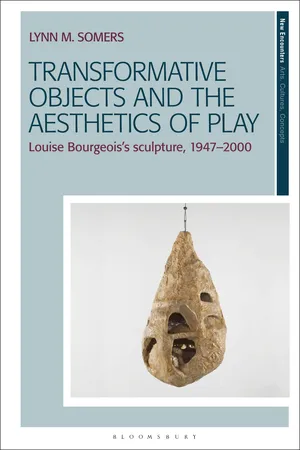
Transformative Objects and the Aesthetics of Play
Louise Bourgeois's Sculpture, 1947–2000
- English
- ePUB (mobile friendly)
- Available on iOS & Android
Transformative Objects and the Aesthetics of Play
Louise Bourgeois's Sculpture, 1947–2000
About this book
This book considers the sculpture of Louise Bourgeois (1911-2010) in light of psychoanalyst D. W. Winnicott's (1896-1971) radical ideas regarding transitional objects, potential space, and play, offering a model for exploring the complex and psychologically evocative work Bourgeois produced from 1947 to 2000.
Critical concepts from British object relational theories – destruction, reparation, integration, relationality and play – drawn from the writings of Winnicott, Melanie Klein, Marion Milner, and Christopher Bollas, among others, bear upon the decades-long study of psychoanalysis Bourgeois brought to her sculptural production that was symbolic, metaphorical, and most importantly, useful. The book demonstrates how Bourgeois's transformative sculptural objects and environments are invested in object relations, both psychical and tangible, and explores Bourgeois's contention that the observer physically engage with the intricate sculptural objects and architectural spaces she produced. Each chapter focuses on a key body of work – Femme Maison, Personages, Lairs, Janus, and Cells – examining how these imaginative and playful objects are staged as embodied encounters in space and time to invoke the mutuality, reciprocity, and ambivalence of our object relationships. Weaving a tapestry of aesthetic, cultural, and psychological encounters, Transformative Objects and the Aesthetics of Play addresses critical relationships among Bourgeois's work and that of other artists from Pieter Brueghel to Eva Hesse. It brings together practical, archival, and theoretical material, offering close examinations of historically situated objects and analyses of their complex affects and spatiality. Gathering critical perspectives from psychoanalysis, cultural analysis, feminist, queer, literary and affect studies, the book extends its specific art historical scope to investigate the crucial roles that art and cultural experience assume in everyday life.
Frequently asked questions
- Essential is ideal for learners and professionals who enjoy exploring a wide range of subjects. Access the Essential Library with 800,000+ trusted titles and best-sellers across business, personal growth, and the humanities. Includes unlimited reading time and Standard Read Aloud voice.
- Complete: Perfect for advanced learners and researchers needing full, unrestricted access. Unlock 1.4M+ books across hundreds of subjects, including academic and specialized titles. The Complete Plan also includes advanced features like Premium Read Aloud and Research Assistant.
Please note we cannot support devices running on iOS 13 and Android 7 or earlier. Learn more about using the app.
Information
Table of contents
- Cover
- Half-Title Page
- Dedication
- Series Page
- Title Page
- Contents
- List of Illustrations
- Acknowledgments
- Series Editor’s Preface
- Introduction
- 1 Femme Maison and the Materiality of Home (1945–1949)
- 2 Personages: Making, Transition, and Use (1946–1955)
- 3 Unruly Objects (1960–1968)
- 4 Janus: Mothers, Ambivalence, and Play (1968–1989)
- 5 Cells: Evocative Object Worlds (1991–2010)
- Conclusion
- Notes
- Bibliography
- Text Credits
- Index
- Copyright